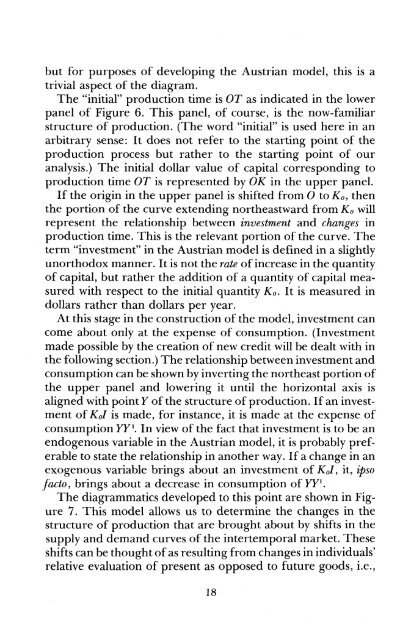Austrian Macroeconomics - Ludwig von Mises Institute
Austrian Macroeconomics - Ludwig von Mises Institute
Austrian Macroeconomics - Ludwig von Mises Institute
Create successful ePaper yourself
Turn your PDF publications into a flip-book with our unique Google optimized e-Paper software.
ut for purposes of developing the <strong>Austrian</strong> model, this is a<br />
trivial aspect of the diagram.<br />
The "initial" production time is OT as indicated in the lower<br />
panel of Figure 6. This panel, of course, is the now-familiar<br />
structure of production. (The word "initial" is used here in an<br />
arbitrary sense: It does not refer to the starting point of the<br />
production process but rather to the starting point of our<br />
analysis.) The initial dollar value of capital corresponding to<br />
production time OT is represented by OK in the upper panel.<br />
If the origin in the upper panel is shifted from 0 to K o, then<br />
the portion of the curve extending northeastward from K o will<br />
represent the relationship between investment and changes in<br />
production time. This is the relevant portion of the curve. The<br />
term "investment" in the <strong>Austrian</strong> model is defined in a slightly<br />
unorthodox manner. It is not the rate ofincrease in the quantity<br />
of capital, but rather the addition of a quantity of capital measured<br />
with respect to the initial quantity K o• It is measured in<br />
dollars rather than dollars per year.<br />
At this stage in the construction of the model, investment can<br />
come about only at the expense of consumption. (Investment<br />
made possible by the creation of new credit will be dealt with in<br />
the following section.) The relationship between investment and<br />
consumption can be shown by inverting the northeast portion of<br />
the upper panel and lowering it until the horizontal axis is<br />
aligned with point Y ofthe structure ofproduction. Ifan investment<br />
ofKoI is made, for instance, it is made at the expense of<br />
consumption YYI. In view of the fact that investment is to be an<br />
endogenous variable in the <strong>Austrian</strong> model, it is probably preferable<br />
to state the relationship in another way. If a change in an<br />
exogenous variable brings about an investment of KoI, it, ipso<br />
facto, brings about a decrease in consumption of YYI .<br />
The diagrammatics developed to this point are shown in Figure<br />
7. This model allows us to determine the changes in the<br />
structure of production that are brought about by shifts in the<br />
supply and demand curves of the intertemporal market. These<br />
shifts can be thought ofas resulting from changes in individuals'<br />
relative evaluation of present as opposed to future goods, i.e.,<br />
18

















